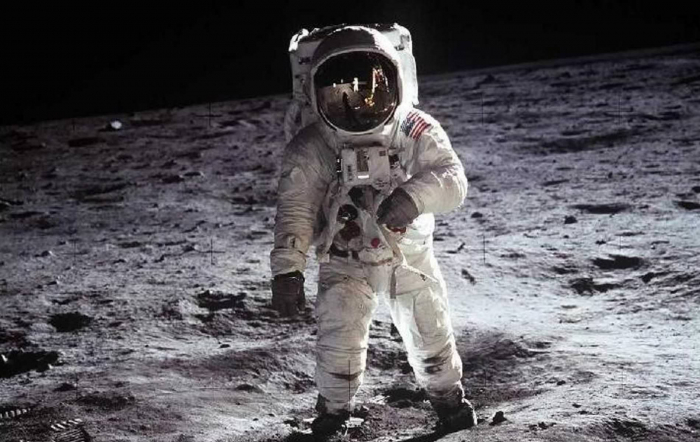Actually, that was Alan Shepard with a golf club during the Apollo 14 mission. And that wasn’t a golf cart. It was a lunar rover, and it also came later: David Scott and James Irwinused one for the first time during the Apollo 15 mission. Considering that Americans lost interest in watching missions to the Moon after the first landing, you can be forgiven for not keeping all the details straight. You might be wondering just how many missions and how many people have been to the Moon. In fact, during nine Apollo missions, 24 astronauts went to the Moon, and 12 of them had the opportunity to walk on it.
In 1961, after the Soviet Union sent the first man, Yuri Gagarin, into space to orbit Earth, Pres. John F. Kennedy announced that the United States would send the first man to the Moon by the end of the decade. NASA subsequently began a series of test missions, starting with Mercury (six one-man spaceflights, 1961–63) to get a sense of how humans function in space, then Gemini (two uncrewed and 10 two-man spaceflights, 1964–66), which helped develop techniques for later lunar landings, and culminating with the Apollo program (1966–72). Apollo began with a series of uncrewed flights orbiting Earth. In 1968 Apollo 7 was the first crewed spaceflight of the program, orbiting Earth 163 times to test the equipment.
Apollo 8 (December 21–27, 1968) was the first crewed mission to complete lunar orbit and return safely to Earth. Its three-man crew of William Anders, Frank Borman, and Jim Lovell were the first three people to go to the Moon, although they did not land. They were followed by the three members of Apollo 10 (May 18–26, 1969): Thomas Stafford, John W. Young, and Eugene Cernan, whose mission was regarded as a dress rehearsal for the lunar landing. Cernan and Stafford piloted the Lunar Module near the Moon’s surface, while Young remained on the Command Module, orbiting the Moon and setting up the routine most subsequent Apollo missions would follow.
Finally came Apollo 11 with the first lunar landing, wherein Neil Armstrong became the first person to walk on the Moon. He was followed quickly by the second person to walk on the Moon, Buzz Aldrin, while Michael Collins remained on the Command Module orbiting the Moon. Collins was the ninth person to reach Earth’s closest neighbor. Apollo 12 (November 14–24, 1969) came soon after, with Pete Conrad and Alan Bean spending almost 32 hours on the Moon’s surface while Richard F. Gordon manned the Command Module in lunar orbit.
Apollo 13 (April 11–17, 1970) was meant to be a routine mission to the Moon, but an oxygen tank exploded two days after launch, and plans to land were quickly aborted. To return to Earth, however, the spacecraft needed to orbit the Moon. The three crew members—Jim Lovell, Fred Haise, and Jack Swigert—shut down the Command Module to conserve energy and moved to the Lunar Module as a makeshift lifeboat. They spent nearly four days in lunar orbit with high levels of carbon dioxide, little heat, and insufficient food and water supplies. Although the three men did not have the chance to walk on the Moon, Haise and Swigert became the 13th and 14th men to reach it (Lovell had been to the Moon on Apollo 8). After a harrowing journey, the crew returned safely to Earth.
Apollo 14 was a little less hair-raising. Alan Shepard, who had been the first U.S. astronaut to travel in space aboard Freedom 7 in 1961, became the fifth person to walk on the Moon and, as an avid golfer, swung at a couple of golf balls. Edgar Mitchell joined him as the sixth person to walk on the Moon, while Stuart A. Roosa orbited in the Command Module, becoming the 17th man to reach the Moon. During Apollo 15 (July 26–August 7, 1971), astronauts David Scott and James B. Irwin spent almost three days on the Moon and were the first to use the lunar rover, an electrically powered wheeled vehicle, while Alfred Worden orbited the Moon on the Command Module.
John W. Young, who had previously been to the Moon on Apollo 10, had the opportunity to walk on it, along with Charles M. Duke, Jr., during Apollo 16 (April 16–27, 1972). The two were the ninth and tenth astronauts to walk on the lunar surface. Thomas K. Mattingly, who had been removed from Apollo 13 because of exposure to measles, manned the Command Module and became the 21st person to reach the Moon. Apollo 17 (December 7–19, 1972) was the last crewed mission to the Moon. Harrison Schmitt, the first professional geologist on the Moon, and Eugene Cernan, who had been to the Moon with Apollo 10, walked on the lunar surface for more than 22 hours. They collected over 249 pounds (115 kg) of rocks and other material. They were the 11th and 12th astronauts to walk on the Moon, and Ron Evans, who manned the Command Module, became the 24th man to reach the Moon.
The end of the Apollo program came as the public’s interest waned and congressional funding was needed elsewhere. Since then no other countries have sent crewed missions to the Moon. NASA moved toward more modest programs and began to diversify its astronaut groups at the end of the 1970s. Consequently, no woman or person of color has had the opportunity to travel to, let alone walk on, the Moon. The only humans to have been there so far are an exclusive club of 24 white men from the United States.
Read the original article on britannica.com.
More about: Moon















































